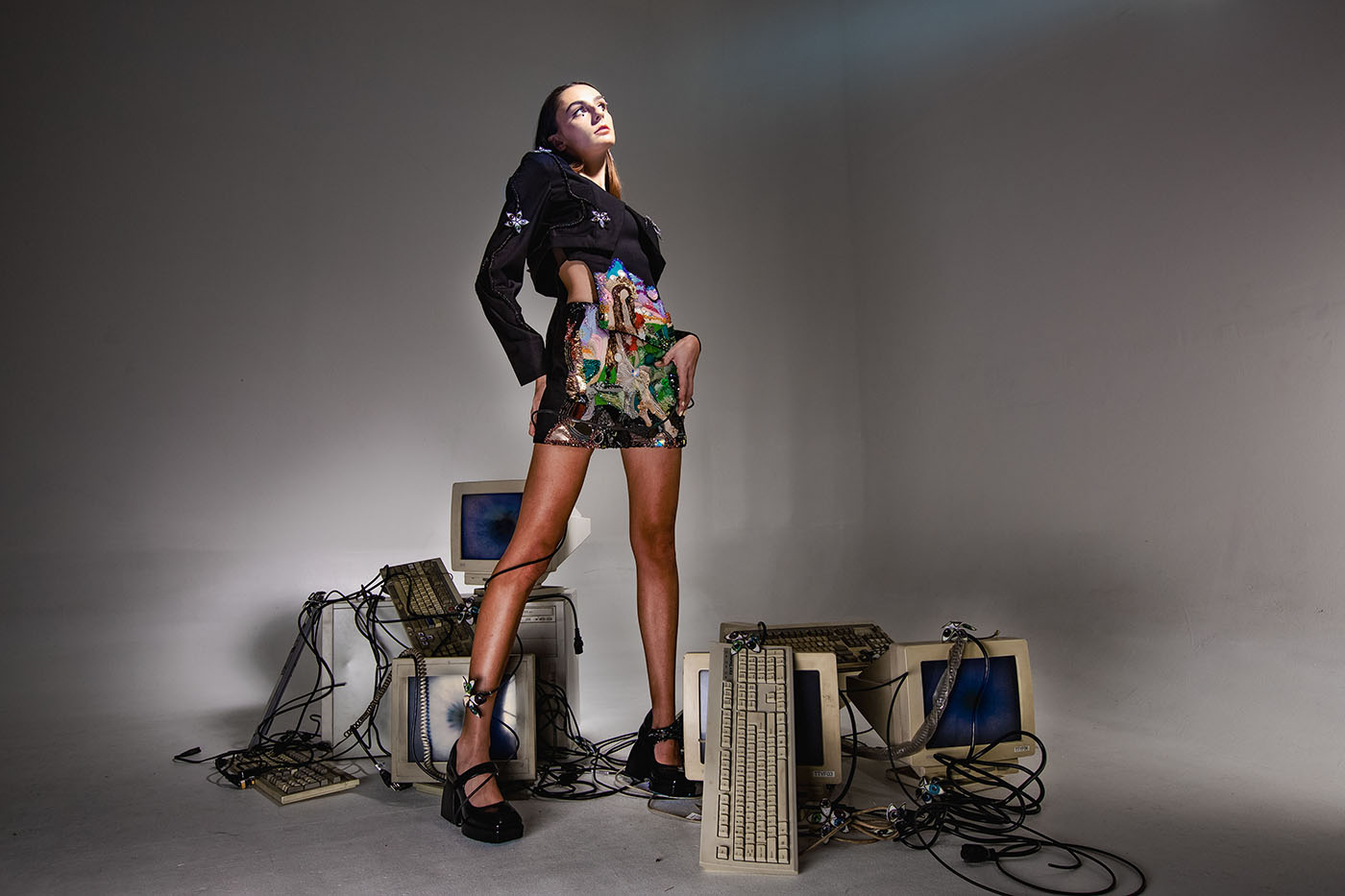Embroidery Unveiled: A Stitched Narrative of Tradition and Innovation by Rachel Ellenbogen
by Diane PERNET
Thanks to my dear friend Miguel Villalobos I discovered the work of Rachel Ellenbogen.
DP: In a world dominated by digital media, where craft forms often take a backseat, your work in embroidery stands out as a testament to traditional artistry. What motivated you to explore this age-old technique in a contemporary context?
RE: I’ve always loved to draw, and express myself through similar visual mediums. It was only after I went to see “Savage Beauty,” the Alexander McQueen exhibition at the Met when I was 10 years old, that I decided I wanted to go into fashion. In high school I found a love of colored pencil and portraiture in my AP art class, and as I went through my first few years in college at Parsons only making clothes, I started to miss working in 2D. From there embroidery sort of fell into my lap in late 2018. I had tried it a few times earlier only using a needle and thread to make simple designs, but it wasn’t until I found myself in a bead store that I wandered into from the street, that I felt inspired to start incorporating them into my work.
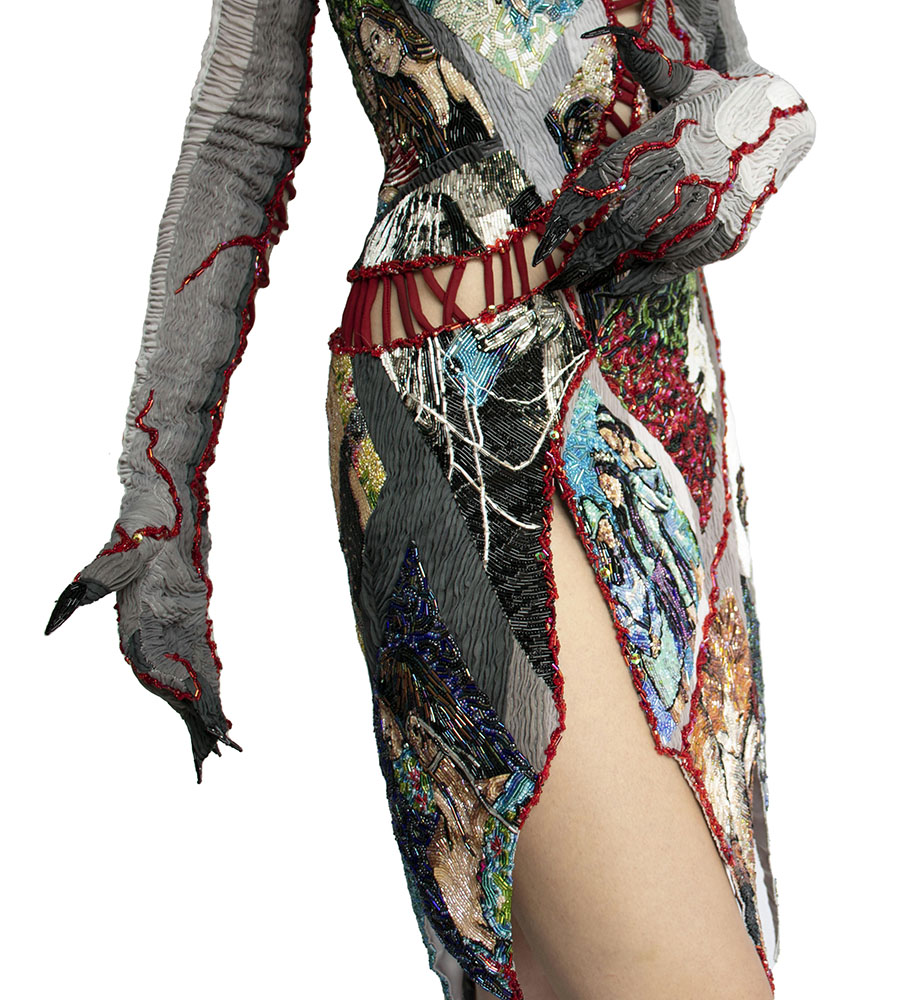
My professor at the time, Kathy Maggio, recommended I take a class in tambour embroidery from Silvia Perramon, an extremely talented embroiderer based in Milan. From there it came pretty naturally. I didn’t start exploring portraiture until around 2021. I had made attempts before, but it wasn’t until then that I actually went somewhere with it. I think to sum it all up, I wanted to find a way to incorporate my 2D style of artwork that I felt was missing from my work into my chosen field of fashion design and create something that felt like me.
DP: The intricacy and attention to detail in your embroidered pieces are truly remarkable. Could you walk us through your creative process, from the initial inspiration to the final stitches? How do you ensure that each stitch contributes to the overall narrative of your work?
RE: Thank you. My ideas usually come to me in very random moments when something just clicks, or sometimes nothing clicks at all and I just have to start working until it does. I usually will start off with an image or an idea, or even just new beads that I like the color of. My final project for Parsons was initially inspired by my discomfort at being observed. The planning process can sometimes be longer than the embroidery process. I have to make sure all of my patterns and images are the proper sizes and shapes before a single bead can be sewn on. Once the embroidery starts I just zone out. Because of my background in colored pencil, the placement of each bead just comes naturally.
DP: Many people perceive embroidery as a conservative and decorative art form, yet your creations challenge those preconceived notions. How do you use embroidery as a medium to convey deeper messages or provoke thoughtful discussions?
RE: I have learned that I don’t have much control over the narratives that happen around my art, especially on the internet. This past week has been life altering for me, all because of a conversation about the price of one of my small purses. The discourse around the amount of work that goes into something as intricate as embroidery or even the amount of unseen and unappreciated work that goes into making the clothes that we wear on our backs every day, is a really important conversation that we need to be constantly having as consumers, and I’m happy that my purse could reignite this conversation.
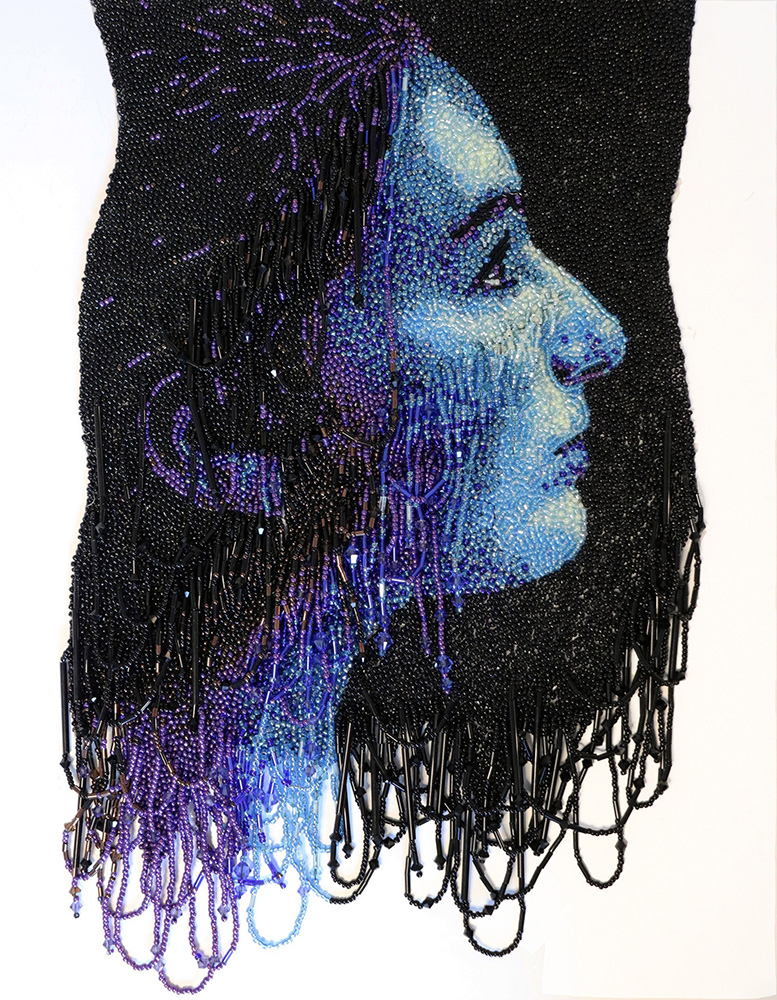
DP: The concept of time often intertwines with craftsmanship, particularly in embroidery, where patience and precision are paramount. How do you navigate the delicate balance between embracing the meditative nature of your art and meeting the demands of today’s fast-paced world?
RE: I don’t think I have found that balance yet. Especially with using social media as a tool to promote my work, algorithms do not take kindly to intermittent posting and delayed gratification. I don’t think I’m interested in meeting the demands of the fast paced world. I would rather make fewer pieces of high quality than try to make other people’s demands for speed, and produce work that doesn’t meet my standards. The audience of people who like my work and are interested in purchasing, understand the slow process because they aren’t looking for instant gratification, they’re looking for something special.
DP: How do you decide which ideas are best suited for embroidery, and how do you adapt your technique to suit different concepts?
RE: I think any idea is suited for embroidery, however the size of beads can be limiting to how much detail can go into a small space. The beads are like pixels, so the larger the surface area is, the higher the resolution of the image. My bead placement on small embroideries has to be thought out much more than larger ones because one wrong bead could mean an unrecognisable image.
DP: In a society that tends to prioritise instant gratification, your dedication to the slow and meticulous process of embroidery is truly admirable. What would you say to those who question the relevance of such time-consuming craftsmanship in today’s instant-access culture?
RE: I think the fact that it’s against the norm makes it that much more important. I think that our instant access culture has become quite dangerous in that many people have forgotten that there’s always another person at the other end of the supply chain, at least in the case of fashion. Fast fashion has given some people unrealistic expectations for pricing and the value of the time of small independent designers. I think as a culture we could use a little slowing down and reflection on these facts.
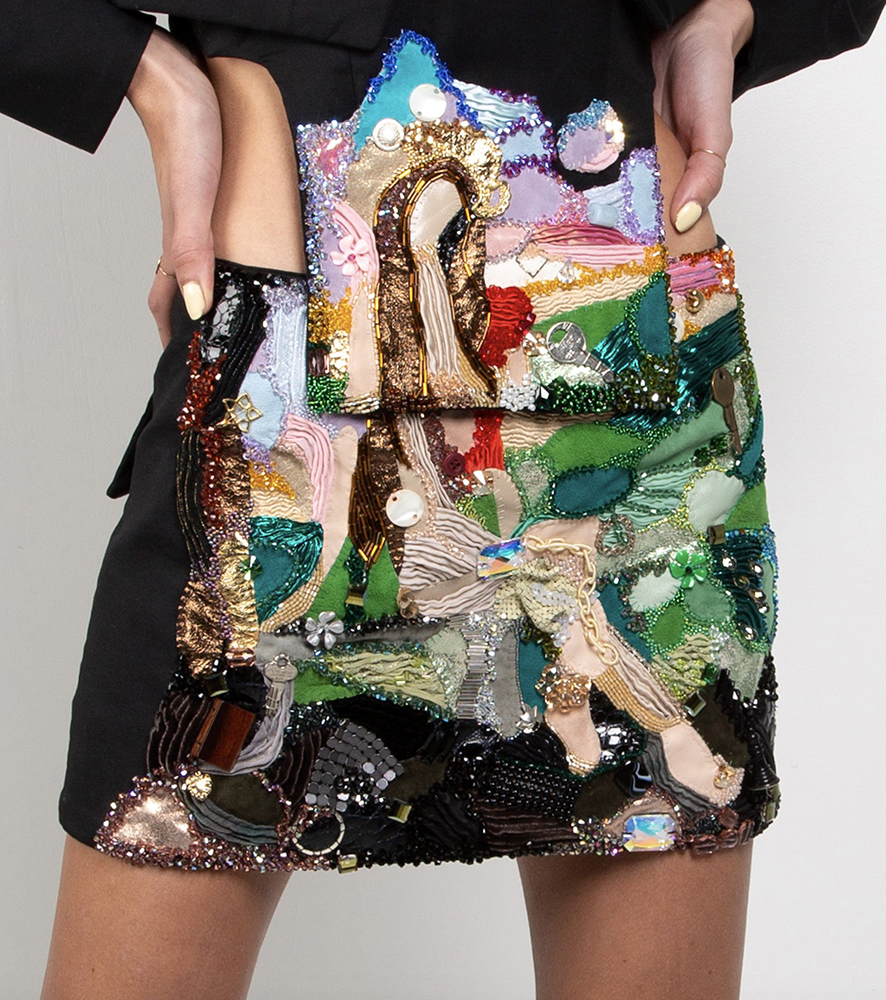
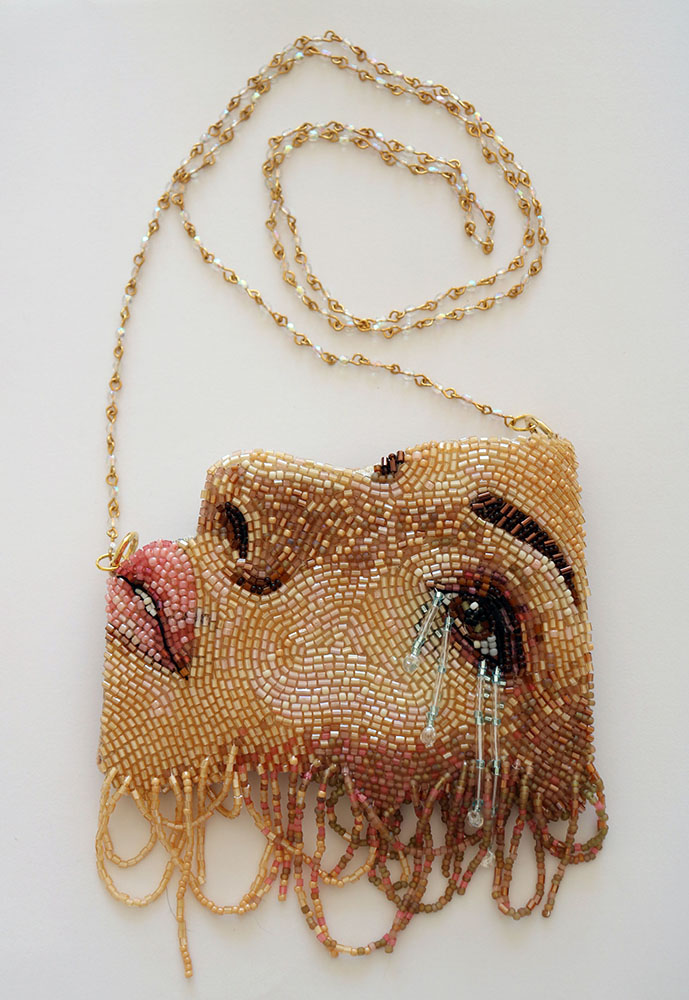
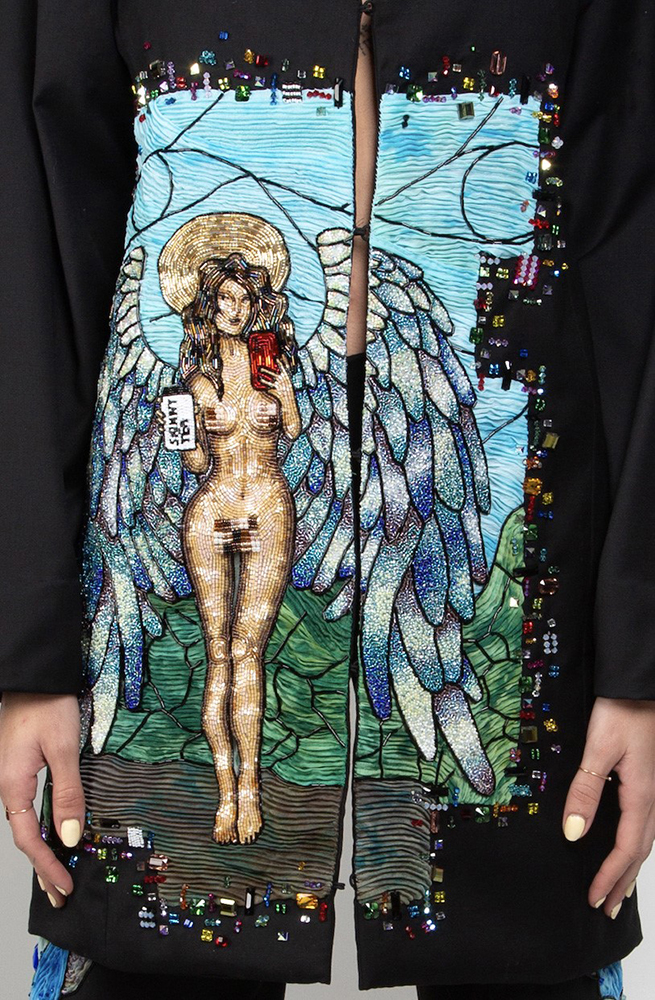
DP: Collaboration has become increasingly prominent in the creative realm, fostering interdisciplinary connections. Have you explored any collaborative projects where embroidery interacts with other art forms? If so, how has this cross-pollination influenced your artistic perspective?
RE: I haven’t explored any collaborations yet. It’s something that I am looking forward to and since my video went viral I’ve gotten some really interesting requests.
DP: Your work demonstrates a keen eye for color, texture, and composition. How do you approach the selection of materials and techniques to ensure they harmonise and enhance the overall impact of your embroidered pieces?
RE: I try not to think too hard about it to be honest. I find that when I put myself on autopilot and trust my gut, I get much better results than if I dwell on small choices. Colour and texture are the main reason I do what I do. I find looking at the different beads and fabrics all day to be a form of entertainment within itself. If I start to get a little bored, I can switch to a different part of the piece using a different color and get sucked back in.
DP: As a student at Parsons, you’re exposed to a multitude of influences and creative minds. How has your time at the renowned institution shaped your artistic journey and pushed the boundaries of your embroidery practice?
RE: Parsons pushed me out of my comfort zone. I learned to see the design process differently, and was allowed to customise it to myself. I wasn’t truly comfortable in my embroidery ability until my final year there, where my two very talented teachers, Miguel Villalobos and Mariana Vidal pushed me to explore different ideas beyond what I thought I was capable of doing at the time. Before my senior year, I primarily did small portraits and patterns with beads. They both really pushed me to experiment with many different materials and textures and pull inspiration from sources I never would have thought to use before, one of those sources being using AI generated images that ended up deepening the concept for the project.
DP: Looking ahead, what aspirations and goals do you have for your embroidery work? Are there any particular techniques or subjects you’re eager to explore in the future?
RE: My goal with my embroidery is to make beautiful things that persuade people to think. I would like to grow as an artist to explore new ideas and push my boundaries without fear of how the work will be received by others and to become more comfortable with failing. I’m eager to explore a less programmed approach in my embroidery, to be able to just make something without as much planning.

